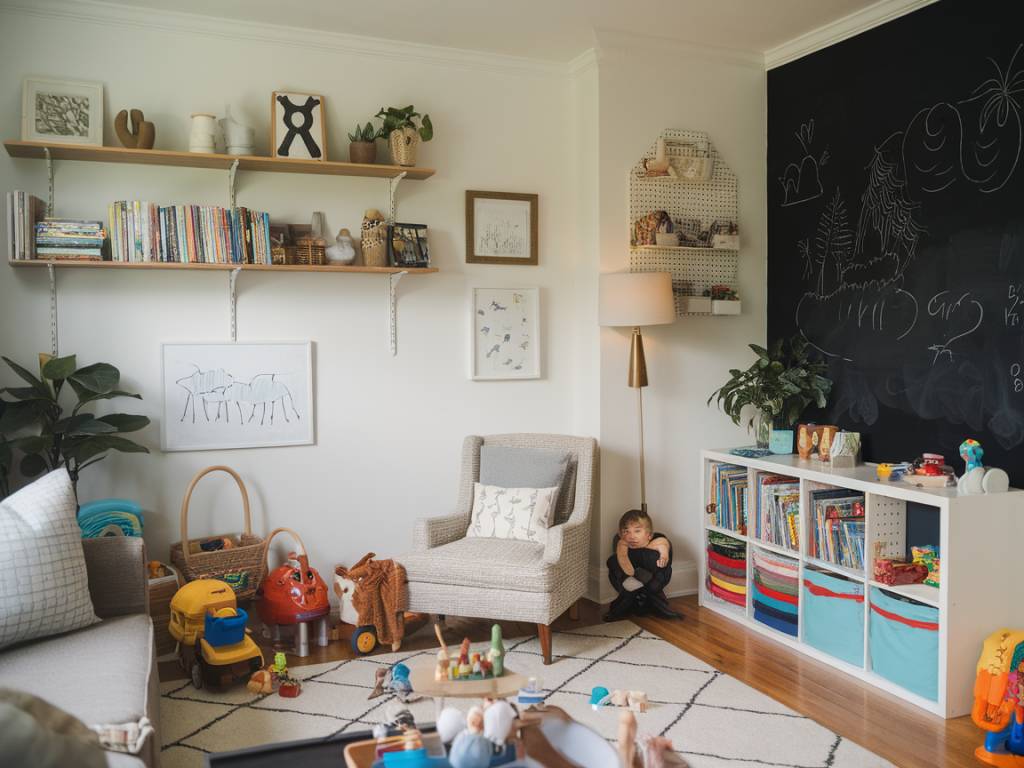Why Create a Home Play Area That Evolves with Age?
Creating a flexible and age-appropriate indoor play area is more than just a practical choice for families—it’s a powerful way to encourage motor skill development, creativity, and independent play. A well-organized, evolving home play space adapts to your child’s developmental stages, grows with their needs, and contributes to their overall well-being.
Incorporating a play area into your home does not require an entire room. With the right strategy and safety considerations, even a small corner can become a dynamic space that stimulates your child’s imagination. This is particularly relevant for parents and caregivers who value early childhood development and want to make intentional choices in their home design.
Key Factors to Consider When Designing an Age-Adaptive Play Area
Before selecting items or choosing a theme, here are essential factors to consider:
- Safety: Rounded furniture edges, non-toxic materials, age-appropriate toys, and adequate supervision should always be your top priorities.
- Flexibility: Opt for furniture and storage systems that can adapt and be rearranged as your child grows.
- Visual stimulation: Use colors and textures to engage curiosity without overwhelming the senses.
- Zoning: Create activity-specific areas: a cozy reading nook, a sensory corner, or a pretend play zone, for example.
- Storage: Tidy play equals focused play. Use open bins, labeled drawers, and child-accessible shelves to encourage independence.
Designing a Play Space for Infants (0-12 months)
Infants need a safe, minimalist environment focused on sensory exploration. Keep visual clutter to a minimum and provide high-contrast stimulation and soft textures.
- Key Features: Soft play mats, a mirror mounted at floor level, sensory toys, and a baby gym with detachable elements.
- Must-Have Items: A comfortable tummy time area, black-and-white visual cards, a secure playpen, and a few rotating interactive toys that encourage grasping and rolling.
- Pro Tip: Keep the play area low to the ground and avoid overstimulation. At this age, slow and simple is best.
Play Spaces for Toddlers (1-3 years): Movement and Exploration
Toddlers thrive in active environments that support fine and gross motor development. This phase is about experimenting through movement, imitation, and tactile discovery.
- Suggested Zones: A climbing cube, a water table, a mini kitchen set for pretend play, and a reading corner with board books.
- Encouraged Materials: Building blocks, sensory bins, ride-on toys, and musical instruments like shakers or drums.
- Safety Focus: Anchor furniture, pad sharp corners, and install non-slip mats to accommodate frequent movement and occasional falls.
Use low IKEA-style open shelving to display toys. Rotating toys weekly can keep toddlers engaged without adding more clutter.
Preschool Play Areas (3-5 years): Imagination and Structure
At this stage, children begin to role-play, build complex structures, and engage in group interactions. A preschooler’s area should balance open-ended play with gentle structure to encourage learning and storytelling.
- Recommended Additions: Art supplies (washable markers, crayons, large-format paper), a puppet theater, dress-up clothes, wooden puzzles, and magnetic tiles.
- Learning Play: Include alphabet toys, counting games, and storytelling prompts such as picture story cubes or themed cards.
- Encourage Growth: Let your child participate in organizing new zones. This autonomy supports executive functioning and responsibility.
Bright yet calm color schemes, child-scale furniture, and multi-use play tables make the preschool play area both functional and inviting.
Early School Years (6-9 years): Creativity and Skill-Building
Once children start school, their play becomes more project-based and independent. A home play zone at this age should blend creative tools with problem-solving opportunities—while still leaving space for movement and rest.
- Primary Elements: A kids’ desk or art station, construction sets (e.g., LEGO, KNEX), science kits, and early coding toys.
- Storage Updates: Use labeled drawers or color-coded bins. Allow your child to curate their own space.
- Reading & Quiet Space: Introduce a reading bean bag chair and shelves where kids can store their favorite novels and comics.
This is also the phase where a “maker mindset” can emerge, so incorporating a small DIY or crafting station can spark long-lasting interests.
Advanced Play Zones for Tweens (10-12 years): Independence and Interest-Based Play
Tweens crave ownership of their space. The play area often shifts into a creative studio or hobby corner, tailored to interests like robotics, music, writing, or design.
- Creative Tools: Digital drawing tablets, modeling clay, photography setups, or basic musical instruments can support sustained interest in hobbies.
- Transitioning the Space: Replace bright primary colors with more muted tones or themes chosen by the child. Add seating suitable for reading, gaming, or socializing with friends.
- Encouraging Autonomy: At this age, children should participate in choosing which items stay, which go, and how their area should evolve next.
Space-Saving Tips for Small Homes or Apartments
You don’t need a dedicated playroom to build an adaptive space. These tips help make the most of limited room dimensions:
- Use Vertical Space: Wall-mounted toy organizers and floating bookshelves save floor area.
- Opt for Foldable or Stackable Furniture: Items like floor cushions, fold-out mats, or stackable bins can be stored when not in use.
- Select Multi-Functional Pieces: A table with built-in storage or a bench that doubles as a toy trunk.
- Zone Hidden Areas: Under-stair nooks or closet corners can be transformed into imaginative pockets for play.
Final Notes: Keep the Play Area Dynamic
A child’s interests and skills change rapidly in the early years. Adapting your home play area in response not only keeps them engaged—it also communicates that creativity, learning, and exploration are valued. By regularly reviewing the space, rotating toys and materials, and involving your child in these decisions, you can maintain an environment that grows along with them.
Whether you’re starting with a newborn or preparing an update for your tween, remember: a thoughtful play space is more than aesthetic, it’s developmental. It’s where magical worlds begin, where growth unfolds, and where family memories are made—right on the living room floor.
